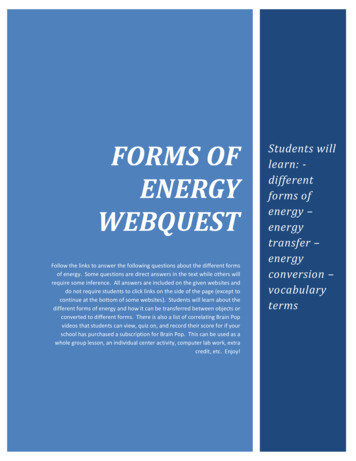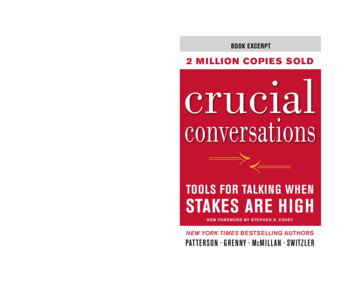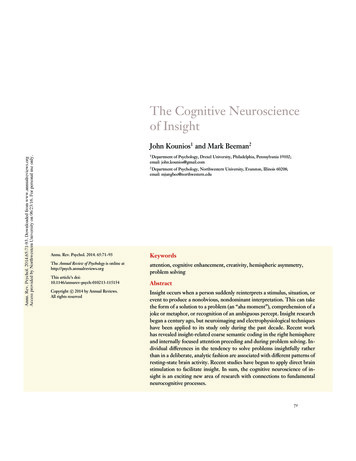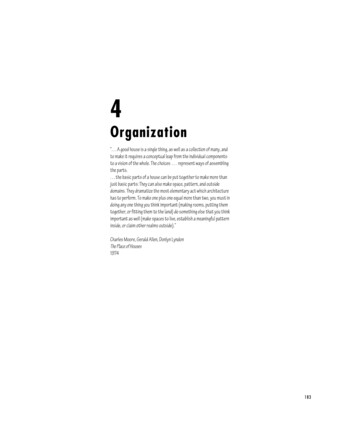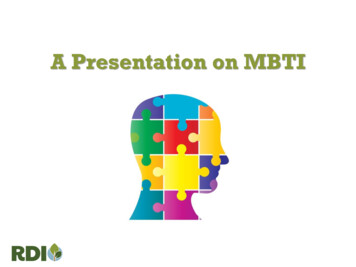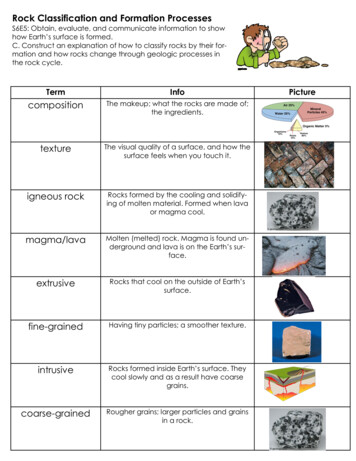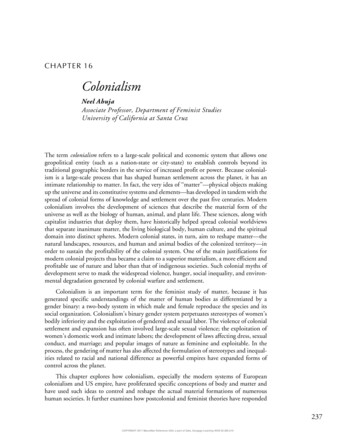
Transcription
CHAPTER 16ColonialismNeel AhujaAssociate Professor, Department of Feminist StudiesUniversity of California at Santa CruzThe term colonialism refers to a large-scale political and economic system that allows onegeopolitical entity (such as a nation-state or city-state) to establish controls beyond itstraditional geographic borders in the service of increased profit or power. Because colonialism is a large-scale process that has shaped human settlement across the planet, it has anintimate relationship to matter. In fact, the very idea of ‘‘matter’’—physical objects makingup the universe and its constitutive systems and elements—has developed in tandem with thespread of colonial forms of knowledge and settlement over the past five centuries. Moderncolonialism involves the development of sciences that describe the material form of theuniverse as well as the biology of human, animal, and plant life. These sciences, along withcapitalist industries that deploy them, have historically helped spread colonial worldviewsthat separate inanimate matter, the living biological body, human culture, and the spiritualdomain into distinct spheres. Modern colonial states, in turn, aim to reshape matter—thenatural landscapes, resources, and human and animal bodies of the colonized territory—inorder to sustain the profitability of the colonial system. One of the main justifications formodern colonial projects thus became a claim to a superior materialism, a more efficient andprofitable use of nature and labor than that of indigenous societies. Such colonial myths ofdevelopment serve to mask the widespread violence, hunger, social inequality, and environmental degradation generated by colonial warfare and settlement.Colonialism is an important term for the feminist study of matter, because it hasgenerated specific understandings of the matter of human bodies as differentiated by agender binary: a two-body system in which male and female reproduce the species and itssocial organization. Colonialism’s binary gender system perpetuates stereotypes of women’sbodily inferiority and the exploitation of gendered and sexual labor. The violence of colonialsettlement and expansion has often involved large-scale sexual violence; the exploitation ofwomen’s domestic work and intimate labors; the development of laws affecting dress, sexualconduct, and marriage; and popular images of nature as feminine and exploitable. In theprocess, the gendering of matter has also affected the formulation of stereotypes and inequalities related to racial and national difference as powerful empires have expanded forms ofcontrol across the planet.This chapter explores how colonialism, especially the modern systems of Europeancolonialism and US empire, have proliferated specific conceptions of body and matter andhave used such ideas to control and reshape the actual material formations of numeroushuman societies. It further examines how postcolonial and feminist theories have responded237COPYRIGHT 2017 Macmillan Reference USA, a part of Gale, Cengage Learning WCN 02-200-210
Chapter 16: Colonialismby rethinking colonial worldviews dividing body from mind and humanity from nature.Overall, the chapter makes clear that colonialism and the capitalist organizations of matter ithas generated over the past five centuries constitute the single most important force shapinghuman societies and the planetary ecologies in which they are embedded. Colonialism is thuscentral to understanding how contemporary concepts and formations of matter have beenshaped by social forces.COLONIALISM: HISTORICAL PERSPECTIVESOne of the best-known examples of colonialism is the establishment of a vast colonial empireby Britain in the eighteenth and nineteenth centuries. This empire oversaw formal, organizedcolonial settlements stretching across the British Isles, eastern North America, the Caribbean,Africa, the Middle East, India, Hong Kong, and Australia. It also exercised informal militaryand economic power in other areas, including Central America, China, and the Pacific Islands.In this system, British state and corporate interests (often located in the empire’s financial andpolitical capital of London) developed a worldwide system for controlling the laws, labor,ecology, and social organization of distant lands and for promoting the political and economicinterests of the English upper and middle classes. If colonialism is a large-scale system fororganizing political and economic power, it is a force grounded in the production of specificcolonial settlements and the networks connecting them. The British, for example, establishedsmall-scale settlements like the city-state of Hong Kong as well as large-scale colonial governments like the British Raj, which stretched across vast tracts of the Indian subcontinent.The term colony usually refers to an organized settlement that individuals from onelocation establish outside the borders of their place of origin. Historically, the term firstreferred to military and agricultural outposts established by Roman citizens in newlyconquered lands of the western Roman Empire. However, as the European imperial states(first Spain and Portugal; then the Netherlands, Britain, and France; and later, Germany,Belgium, and Italy) built navies and overseas corporations to expand their influence and tradeacross continents from the sixteenth through the nineteenth century, the idea of colonialismcame to refer to all manner of economic and political activity characterizing the overseasnetworks that European settlers, corporations, and states controlled outside of Europe. In itsmodern usage, colonialism thus refers to the system by which a state or corporate entitycreates a network of settlements and governing outposts in geographically distant lands andestablishes forms of political, economic, ecological, and military integration between them.Public accounts of world history often whitewash the violent and coercive aspects ofcolonialism. Colonialism is often portrayed as a politically neutral process of populationexpansion, as the inevitable march of progress, or as the tragic response of settlers todiscrimination in their places of origin. As an example of this phenomenon, literary scholarAnia Loomba quotes the definition of colonialism from the Oxford English Dictionary: ‘‘asettlement in a new country . . . a body of people who settle in a new locality, forming acommunity subject to or connected with their parent state; the community so formed,consisting of the original settlers and their descendants and successors, as long as theconnection with the parent state is kept up.’’ Loomba notes that this definitionavoids any reference to people other than the colonisers, people who already mighthave been living in those places where colonies were established. . . . The process of‘‘forming a community’’ in a new land necessarily meant un-forming or re-forming238MA C MI L LA N IN T E RD I S CI P LI NA R Y H AN D BO O K SCOPYRIGHT 2017 Macmillan Reference USA, a part of Gale, Cengage Learning WCN 02-200-210
Chapter 16: Colonialismthe communities that existed there already, and involved a wide range of practicesincluding trade, plunder, negotiation, warfare, genocide, enslavement, and rebellions. (2004, 7–8)History textbooks often continue to suggest the heroism and modernity of colonial explorersand downplay the violence of settlement and labor exploitation.Scholars sometimes distinguish between settler colonialism (a system involving thereplacement of indigenous populations with settler populations through genocide, forcedremoval, intermarriage, or a combination of those methods) and mercantile or metropolitancolonialism (a system that leaves the native population in place but attempts to exploit the landand labor to the benefit of the colonizer). Given this distinction, the formation of settlercolonies like the United States and Israel (which involved the extermination and forced removalof significant portions of the American Indian and Palestinian populations, respectively)exhibit significant differences from that of colonial India (where the British introduced anew class of colonial officials and traders who attempted to profit from reorganizing andmanaging Indian land, ecology, and labor). However, because colonial projects often involve amix of settler violence, displacement of indigenous peoples, reorganization of ecological space,and imposition of new forms of trade and labor, the categorical distinction between these twotypes of colonialism does not always hold. It is necessary to carefully examine the particularforms of colonial domination that manifest under different empires and historical contexts.Although world history is full of the stories of empires that expanded to claim ordominate vast lands and peoples—from the Aztecs to the Romans, the Russians to the USAmericans today—the systems of modern colonialism marked a turning point in history.These empires evolved beyond forms of direct military conquest, tax authority, and agricultural expansion that were common to earlier forms of conquest. Modern colonialism is asmuch about forcing the circulation, labor, and movement of peoples and goods as it is aboutthe direct domination of people and land in specific territories. The development of worldcolonial systems violently marshaled natural resources, human labor, and goods to developthe modern global systems of the nation-state and capitalism. While some scholars argue thatcapitalism was the original process that produced modern European colonialism, it couldequally be argued that the reverse formulation is true: beginning with the transatlanticvoyages and land claims of Italian explorer Christopher Columbus (1451–1506) in the1490s, colonialism was the system that allowed early capitalists to expand the material bases(natural resources and unpaid or low-paid labor forces) needed to accumulate profit from thetransformation of ‘‘nature’’ into commodities and ‘‘humans’’ into workers on a planetaryscale. Colonialism was the enabling condition for the creation of a world capitalist system ofnation-states that expanded from its origins in west-central Europe.European colonial expansion was an inherently violent affair. By laying the groundworkfor profitable transoceanic trades in minerals, agricultural commodities, manufacturedgoods, and enslaved human laborers, colonialism allowed the Spanish, Portuguese, Dutch,British, French, and Belgian monarchies to enrich themselves and to engage in ever-moreintense economic and military competition with one another. This development of colonialtrade networks centered on the development of the Atlantic slave trade, in which approximately 12.5 million people from Africa were turned into tradable commodities and forcedto work in a variety of industries in the Americas and Europe, most notably in sugar andcotton production (The Trans-Atlantic Slave Trade Database 2013). This number does notinclude the progeny of transported slaves, whose ability to reproduce new generations of239GENDER: MATTERCOPYRIGHT 2017 Macmillan Reference USA, a part of Gale, Cengage Learning WCN 02-200-210
Chapter 16: Colonialismenslaved people was understood as part of their value for the planter class, who claimedownership. Although the experience of slavery differed widely depending on the particularwork arrangement and legal context, enslaved peoples often experienced loss of control oversexuality and family structures to the white masters, who viewed them as property. Many ofthe early writings by enslaved men and women focused on the cruelties of slavery, rangingfrom the commonplace rape of female slaves to the separation of children from parents to thebrutal use of physical punishment, murder, and torture to suppress slave rebellion.As colonial mercantile economies developed, they progressively helped settlers displaceindigenous ways of living, including the subsistence practices of American Indian nationsthat utilized seasonal forms of agriculture or engaged in nomadic hunting. Europeancolonialism began in earnest with Columbus’s four voyages on behalf of Spain to theCaribbean (1492 to 1503) and expanded as settler armies and corporations moved inlandto conquer lands across the Americas and, later, Africa, Asia, and the Pacific. At the height ofEuropean competition for colonial land claims in the 1890s, over 84 percent of the earth’slandmass had at one time or another been claimed as a possession of a European imperialstate (according to David Fieldhouse, cited in Loomba 2004, 3).Even after the US, French, and Haitian revolutions, from 1776 to 1804, signaled thedemise of European monarchies and the decline of the aristocracy, the rise of liberalism andrepublicanism and the creation of many new independent nation-states did not stop theintense exploitation of peoples and ecosystems that attended colonial expansion. After theabolition of the Atlantic slave trade, British and Dutch authorities began a new system ofindentured labor that moved hundreds of thousands of Chinese, Indian, and Javaneseworkers from Asia to the former slave plantations of Caribbean colonies, such as Jamaicaand Trinidad. This project explicitly aimed to promote competition between the newimmigrants and formerly enslaved groups in order to prevent the black majority populationsof the Caribbean from taking control from white planters as they had in Haiti (Lowe 2006,193–194). Women were paid on lower scales in the indenture system despite the fact that thelabor recruiters were given incentives to try to recruit them. When reports emerged suggesting the widespread sexual abuse and murder of women in the system, British officialsestablished strict controls over marriage and sexuality that attempted to enforce VictorianChristian gender norms on Indian women who immigrated (Niranjana 2006, 71–72).At the same time that colonial officials used indentured labor to replace formal slavery,colonial expansion continued unabated in the settler colonies that declared independencefrom Britain, as the United States, Canada, and Australia fought a series of wars againstindigenous peoples in order to establish white rule across their respective continents. Thisinvolved ethnic cleansing, displacement, and the concentration of indigenous peopleson reservations. During and after these wars, many native children were removed fromtheir parents and forcibly sent to residential schools in order to assimilate them into whitesettler society. Suddenly transported to faraway locations, children were placed in gendersegregated schools; compelled to do manual labor; subjected to abuse, malnutrition, andpoor sanitary conditions; occasionally forced into arranged marriage; and stripped ofindigenous customs and language. Noting that education leaders explicitly saw the schoolsas a place to remove indigenous cultural traits from children, indigenous activists have sincedescribed the system as a form of genocide. Disease and mortality rates were strikingly high inthe Canadian system, with a 1907 report claiming that 47 to 75 percent of students recentlyreturned from two residential schools had died (Indigenous Foundations 2009). GeraldineBob, a student at the Kamploops residential school on Secwepemc land in British Columbia,240MA C MI L LA N IN T E RD I S CI P LI NA R Y H AN D BO O K SCOPYRIGHT 2017 Macmillan Reference USA, a part of Gale, Cengage Learning WCN 02-200-210
Chapter 16: Colonialismdescribed how young girls were forced to do domestic labor in order to keep the schoolrunning: ‘‘We were just little kids . . . if you can imagine little kids in this school, cleaning theentire school and being forced to do things that are beyond them really. You know, likecleaning the bathrooms, cleaning the tubs, shining the floors.’’ Another student at aresidential school in Manitoba claimed that young girls ‘‘were like slaves’’ (Truth andReconciliation Commission of Canada 2015, 80).The rise of a democratic public culture among the upper and middle classes in the UnitedStates, Britain, and France beginning in the late eighteenth century was the result of profitsgenerated by the colonization of land in the Americas; the establishment of corporate controlsin mercantile colonies in Asia; and the use of enslaved, indentured, or debt-controlledagricultural labor to produce commodities such as sugar, coffee, tea, tobacco, and cotton.Colonial powers developed increasingly complex methods of control that moved from simpleterritorial occupation and forced labor to complex governmental agendas of ‘‘free trade,’’colonial education, land allotment, public health, and colonial police and military force.Thus, even as colonial systems claimed to replace authoritarianism with liberal democracy,the expansion of colonial settlement and trade has continued to reproduce inequality andviolence based on race, nation, class, and gender. By allowing for the economic expansion ofEuropean nation-states and their emerging industrial mode of production, colonialism developed the material basis of global capitalism and the worldwide system of nation-states thatbecame entrenched during the eighteenth and nineteenth centuries.Although large geographic portions of Asia, Africa, and the Caribbean achieved formalindependence from European colonial powers between 1945 and 1981, the systems ofnationalism and capitalism that colonialism set in motion continued to create powerimbalances that favored the economies and militaries of historic colonial powers. For thisreason, many anticolonial activists in the twenty-first century consider decolonization to bean unfinished process blocked by neocolonial economic relations. In fact, even as the UnitedStates emphasized its support of decolonizing states during the Cold War, its growing powerover the international financial, military, and diplomatic systems reinforced the dependenceof these nominally independent states upon Europe and the United States. As such, USempire represents a historical development in the form of colonial power, combining settlercolonialism (the establishment of settler societies across the North American landmass and inCaribbean and Pacific Islands); overseas control of hundreds of military bases and wars ofoccupation, in Vietnam and Iraq; and power over the international systems of finance thatensured trade domination over many former colonies of the Americas, Africa, and Asia.English colonial writer Rudyard Kipling (1865–1936) thus portrayed in an 1899 poemthe 1898 US expansion into the Philippines during the Spanish-American War as a type ofhistorical continuity, with the United States taking on ‘‘the white man’s burden’’ from Britain:Take up the White Man’s burden, Send forth the best ye breedGo bind your sons to exile, to serve your captives’ need;To wait in heavy harness, On fluttered folk and wild—Your new-caught, sullen peoples, Half-devil and half-child.(KIPLING [1899] 1903, 78)Notably, Kipling’s phrasing suggests that the Anglo-American civilizing mission is a gendered process in which white men expand colonial settlements outward in the hope ofmaterially transforming peoples who, by virtue of their race, are understood to exist outsidethe sphere of human morality and development (‘‘half-devil and half-child’’).241GENDER: MATTERCOPYRIGHT 2017 Macmillan Reference USA, a part of Gale, Cengage Learning WCN 02-200-210
Chapter 16: ColonialismRACE AND GENDER: COLONIAL NATURES AND THEMIND-BODY SPLITThe violence of colonialism has always been expressed in the intimate, material terms ofcontrolling bodies, ecologies, and social relations that constitute everyday life. Thus colonialism is a rich topic of study for feminist scholars who wish to understand how gender andsexual power relate to our ideas about the nature of matter and the political and economicforces that organize material inequalities. Although colonial views and uses of nature varybased on context, they have historically tended to justify colonial rule, gender divisions, andthe capitalist transformation of land into commodities. Because colonialism involves outsiders appropriating the land, resources, and labor of a place in the service of profit andpower, it is always accompanied by forms of violence and coercion that attempt to reshapethe material worlds of the indigenous peoples or exterminate them altogether. This violencehas a significant gendered dimension aimed at controlling gender roles, sexuality, domesticlabor, and reproduction.For example, the rise of modern capitalism in western Europe was dependent on theproduction of a shipping economy that, on the one hand, appropriated the natural resourcesof the tropics and the labor and knowledge of colonized American Indian, African, and Asianpeoples and, on the other, exploited the labor of the domestic European peasantry, industrialworkers, and unpaid women whose biological reproduction and household work helpedsustain the colonial capitalist system. By proposing a binary gender system as the natural basisfor dividing men’s public, paid labor from women’s private, unpaid labor, this system helpeddefine economic pursuits as masculine as opposed to spiritual pursuits and domestic labor,which were seen as feminine. Such divisions were also projected onto the colonial projectitself, resulting in the association of races and nations with greater or lesser degrees ofmasculinity based on a colonial vision of industrial progress. In Bengal, the seat of thecolonial government of the British Raj, both British colonizers and anticolonial nationalistsaccepted the idea that European colonizers were successful in government because of theirdomination of the masculine realm of industry, whereas colonized Indians mastered thefeminized domain of spirituality. As such, in resistance to British colonialism, Indiannationalists could attempt to lay claim to material industry without sacrificing spiritualtraditions that women were understood to embody and reproduce. According to Indiancolonial historian Partha Chatterjee (1947–), Indian nationalists resolved political contestsover women’s social status through ‘‘a separation of the domain of culture into two spheres—the material and the spiritual’’ (Chatterjee 1990, 237).European colonialism allowed settlers, traders, and explorers to encounter areas of theworld with which they had little prior familiarity. Thus Europeans often saw colonialism as aneutral project that expanded knowledge of the planet’s geophysical, cultural, and biologicalsystems. The view of colonialism as part of the neutral and inevitable march of humanprogress reflects, in part, the association of colonialism with science. European sciences wereenergized by the discoveries of distant species and by voyages that expanded Europeans’efforts to understand the physical world, including its biological, astronomical, oceanic, andgeologic systems. Colonial travel allowed scientists, including French naturalist GeorgesCuvier (1769–1862) and English biologist Charles Darwin (1809–1882), to catalog andname the many species of animal and plant life that Europeans encountered on othercontinents. This close connection of colonialism and the generation of ideas about naturealso involved attributing certain supposedly ‘‘natural’’ characteristics to different races and242MA C MI L LA N IN T E RD I S CI P LI NA R Y H AN D BO O K SCOPYRIGHT 2017 Macmillan Reference USA, a part of Gale, Cengage Learning WCN 02-200-210
Chapter 16: ColonialismTheodor Galle, c. 1580 reproduction of Jan van der Straet’s c. 1575 drawing, America. Thisimage reflects the association of the colonizer with masculinity and indigenous lands and peoples asfeminized. DE AGOSTINI PICTURE LIBRARY / GETTY IMAGESgenders. Modern colonial enterprises often portrayed both European women and the colonized peoples of the Americas, Africa, and Asia as weak, irrational, hypersexual, and subject tothe whims of instinct. In his pathbreaking study Orientalism (1978), literary scholar EdwardSaid writes that colonialism’s scientific ‘‘impulse to classify nature and man into types’’transforms the conception of the material world into a hierarchical system that separatescolonizer from colonized. For Said, ‘‘the typical materiality of an object could be transformedfrom mere spectacle to a precise measurement of characteristic elements’’ such that a wholenetwork of associations ties geographic, cultural, and physical difference into a vision ofnatural and inevitable inequalities between social groups (Said 2003, 119–120).In this manner, colonial stereotypes commonly advertised that the colonial state had apatriarchal right to govern subject peoples and undeveloped land as well as to appropriate thelabor of subject races (Wolfe 2006, 394–395). Colonialism helped entrench a worldview thatradically separated mind from body, thought from nature, and human from nonhuman. Assuch, it was common for the literature, art, and philosophy of colonial societies to use thebodies of animals, faraway landscapes, non-European races, and women to assemble stereotypes about nature that helped justify colonial forms of settlement and technology (Pratt[1992] 2008; Schiebinger 1993). Many forms of colonial writing and art produced byEuropeans used the figure of the woman’s body to suggest that nature formed the physicaland mental landscape of the colonized. For example, Flemish painter Jan van der Straet’s(1523–1605) illustration America (1575) features Italian colonizer Amerigo Vespucci(1454–1512) awakening an ‘‘America,’’ represented as a nude native woman rising fromher hammock to greet the famed navigator. Closely associated with a passive and idyllic243GENDER: MATTERCOPYRIGHT 2017 Macmillan Reference USA, a part of Gale, Cengage Learning WCN 02-200-210
Chapter 16: Colonialismnature in contrast to the Christian cross, clothing, and advanced technologies (ships,weapons, compass) of the masculine colonizer, the figure of America both invites thewondrous commodities of the colonizer into the so-called New World and stages thetransoceanic encounter of colonization as an inevitable march of progress. This colonialfantasy that the masculine colonizer would seduce the feminized and primitive native withthe wondrous material objects of colonial modernity was betrayed by the brutal facts of sexualviolence in the process of settlement. The journals of Columbus, which detail early Europeantravels to the Caribbean occurring in the same time frame as Vespucci’s voyages, openlydetail the rape and enslavement of native women by Columbus and other men on his ships.In contrast, native artists and writers foreground alternative maps of indigenous life andterritories that preexisted colonial settlement and that resist gendered visions of the land as asite of conquest. Chickasaw literary scholar Jodi Byrd (2011) uses the Chickasaw story ofeastward migration into northern Mississippi as a story to counter British colonial explorerJames Cook’s (1728–1779) westward expeditions that helped to astronomically map thetransit of Venus (2011, xvi). When Cook was murdered following a dispute between hisship’s crew and a group of Hawaiians at Kealakekua Bay, European authors and artists widelyspeculated on the brutality of the Hawaiians, helping to advance a colonial discourse on the‘‘savagery’’ of the natives (Domercq 2009). In response, Byrd foregrounds the Chickasawmigration story depicting twin brothers, Chikasah and Chatah, who are led to a newhomeland with the help of a sacred pole in the earth, a white dog, and observation of theMilky Way. Drawing upon this story that explains how Chikasaw and Choctaw communities separated through migration, Byrd emphasizes how the nation’s indigenous forms ofnavigation understood humans as part of a broader lifeworld that did not separate humansfrom spirits and animals who aided their navigation. In the process, Byrd argues for theimportance of alternative visions of the material world in understanding the continuinglegacies of colonial conceptions of distinctions between nature and culture.Despite continuous indigenous resistance, colonialism generated new ideas thatattempted to justify the material violence of conquest, environmental destruction, andlabor exploitation as expressions of universal ‘‘freedoms,’’ particularly in liberal politicalphilosophies that asserted that European ‘‘civilization’’ liberated colonized peoples by making rational use of their lands and labor (Lowe 2006). Although Enlightenment thinkers likeBritish philosopher and physician John Locke (1632–1704), Scottish philosopher andhistorian David Hume (1711–1776), German philosopher Immanuel Kant (1724–1804),and German philosopher G. W. F. Hegel (1770–1831) are still regarded as key philosophersof human freedom and democracy, their writings suggest that women and non-Europeanraces exist in a lower sphere of natural development separated from the heights of reasonachieved by European man. Locke ([1689] 1963), who invested in British slave-tradingschemes, justified taking Native American territory by claiming a natural right for those whomade what he viewed as productive agricultural use of land. This reflected a dismissal oftraditional forms of sustainable land use—such as the use of common land for subsistence byindividuals in England or the intentional creation of fallow plots in North Americanindigenous agriculture—that were widespread in England and the colonies prior to the riseof the large plantation.Why do colonial powers intensify human inequalities even though they proclaim thatcolonialism is a defense of universal human freedom? This contradiction is often masked,because the logic of colonialism invokes a dualism that separates humans from their materialenvironments. French philosopher René Descartes (1596–1650) is famous for suggesting a244MA C MI L LA N IN T E RD I S CI P LI NA R Y H AN D BO O K SCOPYRIGHT 2017 Macmillan Reference USA, a part of
organizing political and economic power, it is a force grounded in the production of specific colonial settlements and the networks connecting them. The British, for example, established small-scale settlements like the city-state of Hong Kong as well as large-scale colonial govern-

